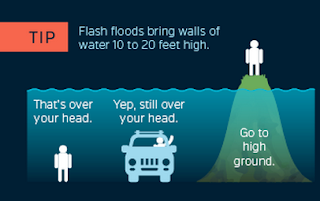From about mid June until the end of September Arizona plays host to a myriad of weather conditions called the Monsoon Season. During this period we get everything from minor dust and wind to electrifying lightning displays and sudden heavy downpours. Serious damage can and does occur. It is not uncommon to see felled trees, downed power lines and outages, and flash flooding. Mother Nature can be very unpredictable, so it's important to be prepared and know what to do if you find yourself in an emergency situation.
Planning ahead
The best way to avoid lightning, flash floods, and other dangerous conditions is by not being in danger in the first place. There are many available ways to gain weather information including:
- Watching current weather forecasts on TV or the internet
- Listening to weather reports on the radio or a NOAA weather radio
- Subscribing to lightning and severe weather notification services
- Scanning the skies 360 degrees around and overhead before leaving a safe location
Be prepared for an emergency by having a 'disaster supply kit' on hand. Have one kit for the car and another kit at home. Every family should prepare a family disaster supply kit to use in the event of severe weather conditions that could knock out power and communications, potentially leaving you stranded for a few days.
Disaster Supply Kit Contents:
- food, water, and sturdy clothing to sustain a family for up to 3 days since electric power, gas and water services may be interrupted.
- 3 gallons of water in clean, closed containers for each person and pet
- First aid kit
- A stock of food that requires no cooking or refrigeration
- Portable and working battery-operated radio, flashlights, and extra batteries (Candles and oil lamps are fire hazards)
- Necessary medications
- Back-up power source for life support or other medical equipment that requires electricity to function
Dust Storms
These are an underrated killer in Arizona! Straight line winds in any thunderstorm can lift huge clouds of dust and reduce visibility to near zero in seconds, which can quickly result in deadly, multi-vehicle accidents on roadways.
Dust storms, or haboobs, are more common during the early part of the monsoon, but can occur at any time during the season, depending on rainfall patterns. Be prepared for blowing dust and reduced visibility any time thunderstorms are nearby.
Remember: PULL ASIDE, STAY ALIVE! If you encounter a dust storm, and cannot avoid driving into it. Pull off the road as far as you can safely do so. Turn off your headlights and taillights. Put your vehicle in "PARK," and/or engage your parking brake, and take your foot off the brake (so your brake lights are not illuminated.) Other motorists may tend to follow tail lights in an attempt to get through the dust storm, and may strike your vehicle from behind. For additional information, see pullasidestayalive.org
Dust storms usually last a few minutes, and up to an hour at most. Stay where you are until the dust storm passes.
Dust storms usually last a few minutes, and up to an hour at most. Stay where you are until the dust storm passes.

Flash Flood Safety
Did you know that each year more deaths occur due to flooding than from any other thunderstorm-related hazard because people underestimate the force and power of water. 66% of flood deaths occur in automobiles that are swept downstream.Many governmental agencies are dedicated to alerting the community to road closures during our thunderstorm season. Most cities pre-deploy barricades and emergency flashers to locations where they know water will be running across roadways causing major problems for motorists.
As little as ten inches of water can float average-sized cars, mini-vans, SUVs and trucks. Strength of the flow is the critical force. Even a less serious urban flood can be dangerous. Driving too fast through standing water can cause a car to hydroplane. The best defense is to slow down or pull well off the road (with the lights off) for a few minutes to wait out heavy rains. Avoid areas that are already flooded, especially if the water is flowing fast. Do not attempt to cross flowing water and do not go around barricades, it's illegal.
When in doubt, wait it out, or find a safer route. If you ignore posted warnings and end up needing to be rescued, you will be responsible for the cost of the rescue (see "stupid motorist law").
If you live in a flood prone area have an evacuation plan. If possible, store materials like sandbags, plywood, plastic sheeting and lumber for protection from floodwaters and to make quick repairs after a severe storm. Store materials above flood levels. Secure wanted objects to prevent them from floating away.
Learn where to find high ground, which is safe from flooding. In a flash flood situation seek high ground quickly.
Contact an insurance agent to discuss flood insurance coverage. Flood losses are not covered under normal homeowners' insurance policies. Flood insurance is available through the National Flood Insurance Program. Get coverage early-there is a waiting period before it takes effect.
Lightning Safety
When thunder roars, go indoors. If you can hear thunder, you are close enough to be struck by lightning. There is no place outside that is safe from a lightning strike. Remaining indoors for 30 minutes after seeing the last lightning and hearing the last thunder will eliminate the risk at the end of storms.If fewer than 30 seconds elapse between the time you see a flash and hear the thunder, then the flash is less than 6 miles away. Research has shown that the most successive flashes are within 6 miles, which means that you should have reached a safe place if lightning is less than 6 miles away.
If someone is struck by lightning, call 911 immediately.



No comments:
Post a Comment